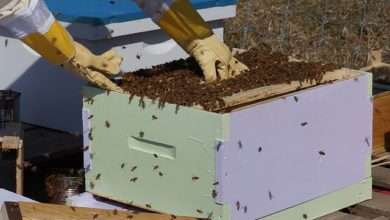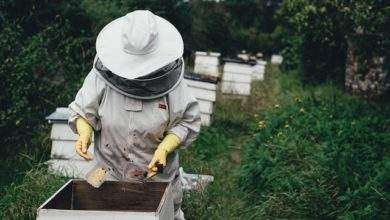Are robbing bees stealing your honey?

What is robbing?
The term “robbing” is used to describe honeybees that invade another hive and steal the honey that has been stored there. The thieving bees break open the sealed cells, load their honey stomachs with the loot, and fly back to their hive. To get to the stores, they will fight the local bees, which could result in the death of numerous bees.
When does robbing occur?
While robbing can happen at any time of the year, it is most noticeable in the late summer or early fall, particularly when there is a nectar shortage. Robbing is frequently observed in the early spring as well, most frequently before the first significant honey flow.
Why does robbing occur?
Compulsive hoarders, honey bees are. Any nectar or honey source, including a weak or poorly defended colony, will do since they will take what they can get. I believe the term “looting” is more appropriate because, like human looters, bees often prey on weak and defenseless individuals, especially in troubled hives.
Take this into consideration: August day, and it’s scorching. It has not rained for days. The few blooms that remain are crunchy and have long since passed their prime. A group of uninterested workers is hanging out, seeking mischief because they have too much free time and nothing to do. One of the groups catches a whiff of something delectable all of a sudden.
The beekeeper has dropped some syrup on a neighboring hive, where the smell is coming from. Following a quick inspection, a few scouts are certain they can defeat the sluggish guard bees lazing in the heat.
How can I recognize robbing?
Unexpected life can sometimes be seen in a poor hive. A hive you thought was dying is now teeming with activity, and you, a novice beekeeper, are overjoyed because bees are populating the area. You believe that things have changed for the colony.
The next day, though, nobody is there when you return. The little colony is destroyed, the honey frames have been robbed of their contents, and bees are lying lifeless on the ground.
The signals can also be more subtle at times:
• Fighting bees swarm, sometimes on the landing board and other times in the air.
• The landing board or the ground in front of the hive is covered with dead bees.
• The back and sides of a hive, as well as all the gaps and seams inside, are frequently observed by robbing bees being examined.
• Wasps are drawn to both the honey and the dead bees when robbing bees; thus, they frequently accompany them.
• Some of the combatants’ bees can have an icy, black appearance. When bees battle, they shed their hair, giving the image described above. It could be the appearance of both attackers and defenders.
• The legs of robbing bees never carry pollen.
• While they wait for an opening to infiltrate the target hive, robbing bees frequently sway from side to side like wasps. As the thieves rip open fresh cells, wax comb fragments can show up on the landing board.
• Bees that are robbing are louder than other bees.
• Robber bees frequently climb up walls before flying away and then dip toward the ground as they take off because they are heavy with honey when they leave the target hive. Even though it might not be apparent right away, if you look at them closely, you can notice it.
What can I do to prevent robbing?
Taking preventive action before a robbery occurs is significantly more effective than attempting to halt it after it has already begun. Here are some tactics that might succeed, at least occasionally.
As soon as there is a nectar shortage, close entrances. If they have a sufficient population and a restricted entrance, bees can successfully defend their hive.
Numerous beekeepers have noted that Italian bees commit robberies more frequently than other subspecies. You need to use extra caution if you keep Italians.
It seems that colonies with no queens are more likely to be robbed than hives with queens. As the season for robberies draws near, make sure all of your hives are queen-right.
The fact that the food source is so close to the hive opening may explain why entrance feeders appear to encourage robbery more than other feeders. If there is a nectar shortage, use a different style of feeder.
The vulnerability of small or frail colonies is greater. Before a nectar shortage, think about uniting such hives.
Commercial robbing screens are incredibly efficient tools that let resident bees enter and exit while preventing robbers. Using them on weaker hives that you don’t want to combine can be extremely beneficial.
What can I do to stop it?
A robbery frenzy is difficult to end once it has begun.
• Smoking will not put an end to robbing, but it will allow you a break while you secure the hive. Start the smoker, and while you work, place it close to the hive.
• A relatively small hole should be used for entrances. Some beekeepers use this tactic to block off the entrance while still allowing some airflow and keeping out robbers.
• If the robbery is really bad, you may just cover the hive hole with hardware cloth or screen at a size the bees can’t go through (#8 or #10 work nicely). Until the robbers give up and completely shut down the hive for a few days. Ensure that the enclosed colony has access to feed, pollen, water, and ventilation if necessary.
• Throwing a towel covered in water over the hive causes the thieves to become confused while allowing the hive’s inhabitants to enter and exit through the towel. The towel’s evaporation keeps the hive cool.
• Install a robbing screen. While the robber bees continue to butt through the screen while following the scent of the hive, this mechanism redirects the hive occupants through a different entrance.
• At the colony’s entrance, some beekeepers apply commercial products like Vicks Vaporub. This product has strong-smelling ingredients, including menthol, camphor, and eucalyptus oil, that confound robber bees and hide the smell of the hive.
• Some beekeepers advise taking the lids off of each and every hive in the apiary. According to the argument, the bees avoid robbing other hives because they are too busy defending their own hives. It will not work, though, if the robber bees are arriving from a location other than your own apiary.
Additionally, it will not prevent wasps or other predators from randomly accessing your hives. This is not a wise course of action for a novice beekeeper.
FAQ
How do you identify a robbing bee?
In contrast to the foraging scenario, where a large number of the bees are obviously bringing back nectar, the robbing bees will approach the hive without any nectar payload.
Robbers do not only fly into the entryway or onto the landing board.
There can be fighting on the ground or close to the entrance.
How long does hive robbing last?
Once robbing begins, the hive collapses in a very short period of time; typically, the hive is destroyed within a day or two. Once the robbing starts, a beekeeper has very little control over the situation. You must act right away if your hive is being burglarized right now.
Are robbing bees aggressive?
The invaders’ army can steal the colony of all its food if the hive is powerless to protect itself during a robbery. Disaster! A hive’s attitude is altered by being robbed. It can be tough to control the bees when they act viciously and aggressively.
What to do after the hive is robbed?
Until the robbers give up and completely shut down the hive for a few days. Ensure that the enclosed colony has access to feed, pollen, water, and ventilation if necessary.






